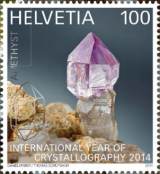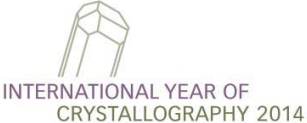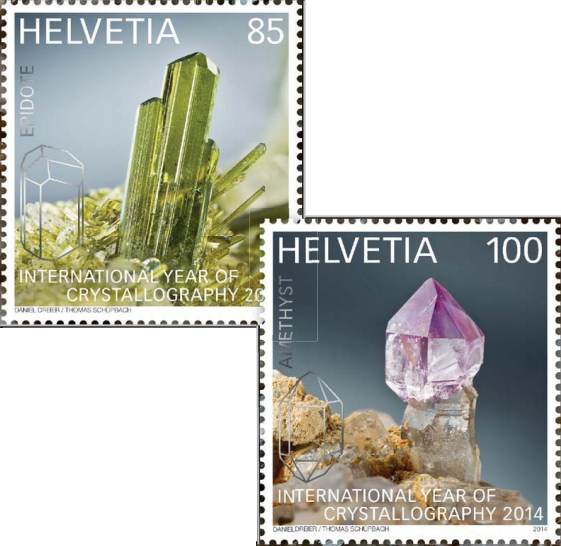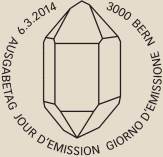
Swiss commemorative stamp issue
 The Swiss Postal Service Die Post will issue two postage stamps on 6 March 2014 to mark the International Year of Crystallography. The stamps show natural crystals of the minerals epidote and amethyst. The stamps are introduced in Die Lupe, the magazine of Die Post, with an article by the President of the Swiss Crystallographic Society.
The Swiss Postal Service Die Post will issue two postage stamps on 6 March 2014 to mark the International Year of Crystallography. The stamps show natural crystals of the minerals epidote and amethyst. The stamps are introduced in Die Lupe, the magazine of Die Post, with an article by the President of the Swiss Crystallographic Society.
Ein Werkzeug der Wissenschaft |
A tool of science |
||
|
Das Verständnis der materiellen Beschaffenheit der Welt gründet vor allem auf Kenntnissen der Kristallographie. So zu lesen in der Resolution der Vereinten Nationen zum internationalen Jahr der Kristallographie. Die Anwendung dieser naturwissenschaftlichen Disziplin ist in der Tat unverzichtbar für die Bewältigung von Herausforderungen wie neuen Materialien, Krankheiten und Umweltproblemen. Die Vereinten Nationen widmen sich jedes Jahr einem speziellen Thema. Aufgrund ihrer Bedeutung für die Gesellschaft stehen wissenschaftliche Themen immer wieder im Fokus. 2010 war es die biologische Vielfalt, 2011 die Chemie, und 2014 wird als internationales Jahr der Kristallographie in die Geschichte eingehen. |
 |
Our understanding of the material nature of our world is grounded in our knowledge of crystallography. So it is stated in the United Nations resolution declaring the International Year of Crystallography. The application of this scientific discipline is indeed indispensable for tackling challenges such as new materials, disease and environmental problems. The United Nations dedicates each Year to a special theme. Because of their importance for society scientific issues always come into focus. In 2010 the theme was biological diversity, in 2011 Chemistry, and 2014 will go down in history as the International Year of Crystallography. |
|
|
Was versteht man unter Kristallographie? Die Kristallographie ist die Wissenschaft von den Kristallen, ihrer Struktur und Symmetrien, Entstehung oder Herstellung und ihrer Eigenschaften und Anwendungsmöglichkeiten. Als einzige Disziplin beantwortet sie die Frage: Wie ordnen sich die Atome in der Materie an? Die Kristallographie beschäftigt sich mit den inneren Symmetrien von Materialien, die sich auch durch die Spaltflächen in der äusseren Form manifestieren. Ein Thema, das schon in der Antike für Faszination sorgte. Ganz am Anfang stand der Philosoph und Naturforscher Theophrastos von Eresos (371–287 v. Chr.) – notabene ein Schüler von Aristoteles. Kristalle lassen erahnen, dass die Natur gewisse Aufbauprinzipien in der Anordnung der Atome walten lässt, die sich mathematisch beschreiben lassen. Diese Annahme wurde 1912 vom deutschen Physiker und Nobelpreisträger Max von Laue und später auch von Vater und Sohn William H. und William L. Bragg bestätigt. Letztere konnten mit Hilfe der damals relativ neu entdeckten Röntgenstrahlen erstmals die Positionen der Atome bzw. Ionen in einem Natriumchlorid-Kristall (Kochsalz) bestimmen. In einem winzigen Würfel sind je vier Natrium- und Chlor-Ionen abwechslungsweise angeordnet. Diese Würfelchen – ordentlich oder im Fachjargon «periodisch» aneinandergereiht – ergeben dann den Kristall. Kristallographie ist in unserem Alltag allgegenwärtig: bei der Entwicklung moderner Medikamente, in der Nanotechnologie und in der Biotechnologie. Sie ist die Grundlage sämtlicher neuer Materialien, von Zahncreme bis zum Flugzeugteil. Wie wichtig die Kristallographie ist, beweisen auch die 29 Nobelpreise, die auf diesem Gebiet verliehen wurden. Das Jahr der Kristallographie – zweifellos ein würdiger Anlass für zwei Sondermarken der Post. Dr. Jürg Schefer,Präsident SGK/SSCr Schweiz. Gesellschaft für Kristallographie |
What is Crystallography? Crystallography is the science of crystals, their structure and symmetries, development or production, and of their properties and potential applications. It is the only discipline that can answer the question: How are atoms organized in solid matter? Crystallography deals with the internal symmetries of materials, but also from the cleavage planes visible in their external form. This topic was already a source of fascination in antiquity. At the very beginning there was the philosopher and naturalist Theophrastus of Eresos (371-287 BC) - a student of Aristotle. Crystals gave rise to the idea that nature applies certain structural principles in the arrangement of atoms that can be mathematically described. This assumption was confirmed in 1912 by the German Physicist and Nobel Prize winner Max von Laue, and later by the father and son William H. and William L. Bragg. The latter were the first to be able to determine the positions of the atoms or ions in a sodium chloride (common salt) crystal, with the help of the then relatively newly discovered X-rays first. Within tiny cubes, clusters of four sodium and chlorine ions are arranged alternately. These cubes - strung together in an orderly, or in the jargon, " periodic " fashion - constitute the crystal. Crystallography is omnipresent in our daily life: in advances in the development of drugs, in nanotechnology and in biotechnology. It is the basis of all new materials, from toothpaste to aircraft parts. The importance of crystallography is demonstrated by the 29 Nobel Prizes that have been awarded in this area. The Year of Crystallography - undoubtedly a worthy occasion for two special stamps by the Post Office.
Dr Jürg Schefer
President SGK / SSCR
Swiss Crystallographic Association
|
||
 Date of issue: March 3, 2014
Date of issue: March 3, 2014
First Day Covers available: 27 February 2014
Design of Stamp: Daniel Dreier, Bern
Photography: Thomas Schüpbach, Ipsach, Belgium
Printing: Offset printing, 4-color, and hot foil stamping; Cartor Security Printing, La Loupe, France
Format: Stamp: 40.5 × 43.5 mm; Sheet: 150 × 204 mm (4 rows of 3 marks)
Perforation: 12 ¾ × 13
© Die Post
Click here to download the leaflet
Click here to download the magazine Die Lupe from the Swiss Post site
| Contact | Anthony Linden anthony.linden@chem.uzh.ch |
| URL | http://www.post.ch/post-startseite/post-privatkunden/post-philatelie/post-philatelie-publikationen/post-philatelie-lupe/ph-lupe-1-2014.pdf |
| Category | postage stamps |


